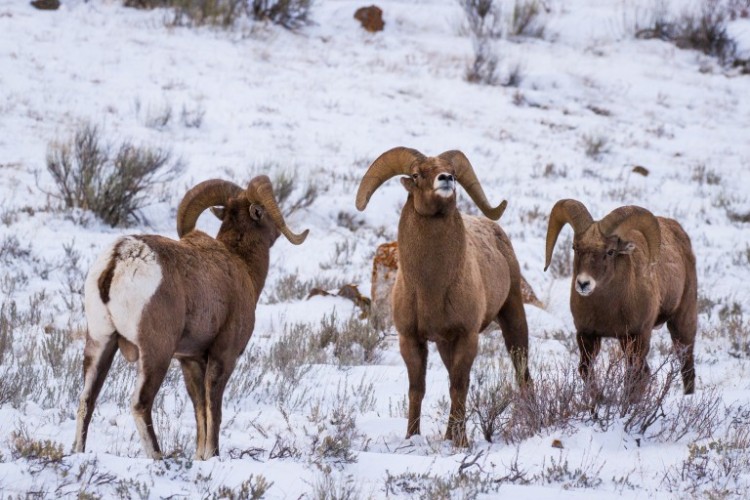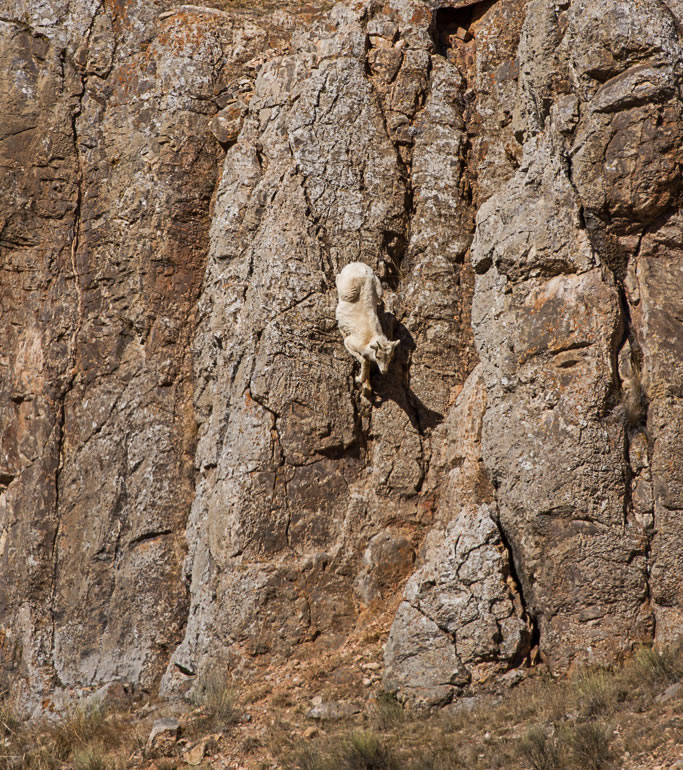Species Profile: Bighorn Sheep


Bighorn Rams square up during the December Rut. Photo: Josh Metten
As winter's grasp approaches, wildlife in the Greater Yellowstone are beginning to migrate to low elevation refuges, avoiding deep snows in the high country. Though many animals like deer, moose, and elk can be found year round in Jackson Hole, bighorn sheep (Ovis canadensis) are most easily viewed during the winter months when they travel from the high peaks of the Gros Ventre Mountains to Miller Butte on the National Elk Refuge. First arriving as early as September, bighorn remain in the valley until the spring, where they return to the rugged mountains some 4,000 feet above. Read on to learn more about this charismatic big game species.
Mountain Athletes
To survive in the Greater Yellowstone Ecosystem, animals carve out specific niches, or specializations. Bighorn are alpine experts. Soft grippy hooves, athletic bodies, and a seemingly nonexistent fear of heights allow bighorn to inhabit rugged terrain usually avoided by other herbivores. Their ability to travel quickly across cliff faces is a tactical advantage which helps them avoid predators and find food, but they also appear to simply enjoy technical exposure. By this time of year even lambs are skilled climbers, having been born in the steepest most rugged terrain their mothers can find the previous spring.

Head Butting
Though the prime season for viewing male dominance and courtship displays in the Tetons is late fall, it also occurs in the spring and to a lesser degree throughout the year. Rams instinctively butt heads to establish a hierarchy. Enlarged nasal cavities and the horns themselves help absorb the shock from blows, whose sound echoes across the landscape. At around age 7, rams are large enough to maintain dominance within a herd and will actively court and mate with most females.
Fall Rut
Like other ungulates (hooved mammals) bighorn rams enter a period of dominance displays called the rut prior to mating in late fall. Displays are highly ritualized, with mature rams first staring at each other, displaying their horns, before abruptly rearing up on hind legs and crashing heads together. With evenly matched rams this will continue for some time until the stamina of one is exhausted and he retreats. Dominant males will then spend time pursuing and guarding females. All hooved mammals have what is called a vaso-nasal gland which enables them to sense when a female is receptive to mating. A lowered head and curled upper lip is a sign of males using this gland, also called a flehmen response.

Currently, bighorn sheep from the Gros Ventre herd are commonly found on the National Elk Refuge, but they are not the only sheep in Jackson Hole. Another, smaller herd is found high in the Tetons. Instead of descending in the fall as snows deepen, this herd ascends to the tops of peaks such as Mount Hunt and Prospector Mountain in Grand Teton National Park. Harsh winter winds blow snow off of these summits exposing enough alpine vegetation for the herd to subsist on at 10,000 feet!
Conserving Bighorn for the future
Winter the hardest time of year on wildlife, who rely on fat reserves from the summer to survive the lack of quality forage. Communities across the country recognize the importance of our wildlife and take steps to protect them. Here in Jackson Hole, the community has enacted seasonal closures in areas of critical winter range. To highlight these areas, Jackson Hole Ecotour Adventures is proud to be a business sponsor of the Don’t Poach the Powder campaign, organized by our partners, The Jackson Hole Conservation Alliance. Thanks to the work of dedicated conservationists, we can experience bighorn sheep in the wild today.
Josh Metten has spent his entire life exploring and living in the Rocky Mountains of Colorado and Wyoming. He is an Ecotour Adventures naturalist, photographer, conservationist, and outdoor enthusiast. Josh lives in Jackson, WY.
Eco Tour Adventures was created with the idea of helping people connect with the natural world through wildlife observation and natural history interpretation. We believe that when one is more familiar with the intricate workings of the ecosystem, he or she has a deeper appreciation and connection with their environment. Join us on an adventure today!













